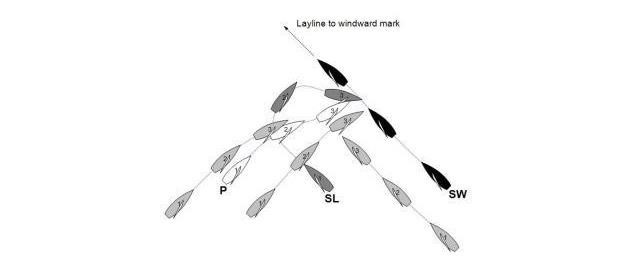


Section B – Boat on boat
RS CALL B8
Rule 2, Fair Sailing
Rule 10, On Opposite Tacks
Rule 11, On the Same Tack, Overlapped
Rule 14, Avoiding Contact
Rule 15, Acquiring Right of Way
Rule 19, Room to Pass an Obstruction
Rule 62.1, Redress
Rule E4.3, Taking a Penalty
Rule E6.9, Decisions on Redress
A boat that deliberately gives up right-of-way and immediately sails into a position in
which she can only avoid contact with one boat by breaking a rule and making
contact with another boat resulting in damage is sailing without concern for the
consequences of her actions. She does not comply with the basic principle of
sportsmanship and the rules.
Assumed Facts
On a beat to windward in 15 knots of wind, SL is on starboard tack, below the lay
line to the wind-ward mark to be rounded to port. SW is on the lay line two boat
lengths to windward and astern of SL.
P is approaching on port tack on a collision course with SW. There are other boats on
port tack, both to leeward and astern of P, as well as others crossing on starboard
tack.
SL crosses ahead of P and immediately tacks onto port to windward of P and onto a
collision course with SW as P starts to bear away to pass close astern of SW. SL then
bears away sharply across the bows of P. P cannot bear away further because of the
other boats to leeward and astern as well as on starboard tack.
 There is contact between the bow of P and the starboard gunwale of SL, with damage
to P, but she finishes the heat. However, repairs are necessary to the bow of P before
she can sail again.
P protests. SL takes a One-Turn Penalty and continues to race.
There is contact between the bow of P and the starboard gunwale of SL, with damage
to P, but she finishes the heat. However, repairs are necessary to the bow of P before
she can sail again.
P protests. SL takes a One-Turn Penalty and continues to race.
Question 1
Which rules apply?
Answer 1
Before she tacked, SL was the right-of-way boat with respect to both SW and P.
When she tacked, she was immediately required to take action to avoid SW (rule 10).
SW became an obstruction to SL at the moment SL passed head to wind. P is
required to give SL room to pass this obstruction unless, from the time SL became
overlapped to windward, P was unable to give that room (rule 19.2(b)) – which was
the case because of the other boats to leeward and astern of her as well as on
starboard tack.
As both P and SW acquired right-of-way with respect to SL as a result of the actions
of SL, neither P nor SW are required initially to give SL room to keep clear (rule 15).
SL, overlapped to windward of P, did not keep clear and broke rule 11. SL could
have avoided contact by not tacking on to a collision course with SW. SL broke rule
14.
SL gave up right-of-way and sailed in to a position in which she could only avoid
contact with one boat by breaking a rule and making contact with another boat. By
sailing without concern for the consequences of her actions, SL did not comply with
the basic principle of sportsmanship and the rules as well as the recognized principles
of sportsmanship and fair play. The protest committee should consider taking further
action under rule 2.
Question 2
Is the One-Turn Penalty taken by SL an applicable penalty?
Answer 2
If the protest committee finds that the damage to P was serious, then SL's penalty is
to retire (rule E4.3(c)).
If the protest committee finds that SL did break rule 2, then a One-Turn Penalty is
not the applicable penalty. SL shall be scored DNE for this heat.
Question 3
Is P entitled to redress?
Answer 3
P finished the heat and her score in that heat had not been made significantly worse
by the action of a boat breaking a rule of Part 2. The conditions for redress in this
heat are not met (rule 62.1).
However, if P is unable to compete in her next heat because of the necessity to repair
damage before racing, then her score in that next heat would be made significantly
worse. If the protest committee finds either that the damage to P was as a result of a
breach of a rule of part 2 or that SL broke rule 2, then P would be entitled to request
redress (rule 62.1(b) or (d), respectively).
Redress would include reasonable time to repair the damage, but not more than
30 minutes (rule E6.9).






